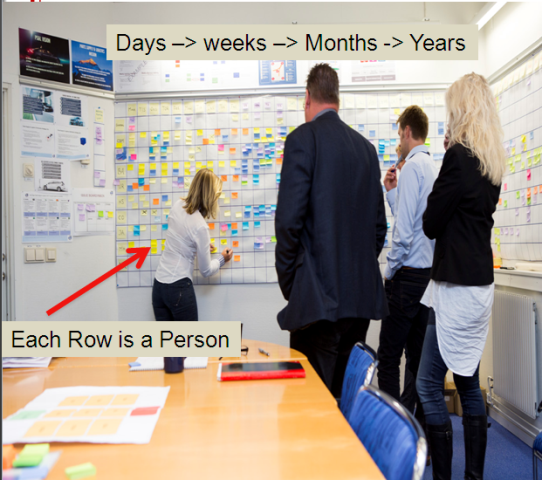A business author’s main joy in writing a book is that people not only read their book but use it like a tool. The people at Volvo Customer Care are doing this in a big way. Their passionate, yet humble Vice President, Einar Gudmundsson, is responsible for the aftermarket business worth $2.3 billion in revenue with $800 million in profit. So why did he need lean? He was not satisfied. He did not want good profits through mediocrity but great profits with completely satisfied customers through excellence.
He struggled to figure out how to apply lean to a service operation, but he was intrigued by my fourteen principles of The Toyota Way organized into philosophy, process, people, and problem solving.
What tied it together into an operable system were the four development stages in The Toyota Way to Lean Leadership—self development, developing others, supporting daily kaizen, and aligning goals and processes (Figure 1 above).
They built a matrix of the fourteen principles x the four stages and described the challenge at each intersection. This became their coaching matrix. Each leader is expected to move through the four stages on each of the fourteen principles, and there is a defined coaching process to help them do it. For example, they must demonstrate that they can achieve a level of self development in “solving problems at the root cause to drive organizational learning.”
Einar was the first to be coached by a Japanese sensei (teacher) and became the head coach to develop his direct reports. Within each cell of the 14 x 4 matrix each leader describes in their own words why accomplishing that cell is important, what specific actions they will take in their area to progress on the principle (blue sticky notes), and reflection on proof they are accomplishing their targets (green or red). The blue sticky notes, the actions, are vetted with their coach, and those that survive become the improvements they will work on through a deliberate plan, do, check, act, cycle.
The management team meets regularly in a visual planning room (see figure 3) where they discuss progress on their actions. Crossing out the item with an X means it was completed on time with high quality, while a slash means they were late or not on time which leads to further problem solving and coaching. As Einar puts it: “We love our visual planning boards. They clarify who delivers what task to whom, when, and where.”

A big part of Einar’s coaching has been to get managers out of wasteful meetings in conference rooms and at the “gemba” (where the people are working) to see and understand the current situation and problems. At the start the senior management spent almost no time at the gemba and this was shifted to an average of 10 hours per week with an ultimate goal of 18 hours per week.
One strategic initiative was a complete rethinking of the service shop that customers experience when they bring in their vehicle. For example vehicles are repaired by cross-functional teams led by a personal service technician assigned to each customer. The entire process has been streamlined from the customer viewpoint leading to reduced cost and thus increased profit and large increases in customer satisfaction.
On May 13, 2013 they received an excellent review from the CEO and his team who had never seen lean applied in this way. They did a walk around and to Einar’s delight there was no powerpoint. Young leaders are catching the fever and meeting on their own to advance themselves even when no senior manager is watching, Einar’s real delight.
Dr. Jeffrey Liker is professor of industrial and operations engineering at the University of Michigan and author of The Toyota Way. He leads Liker Lean Advisors, LLC and his latest book (with Gary Convis) is The Toyota Way to Lean Leadership.
